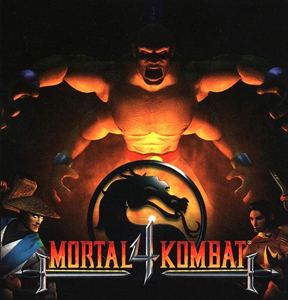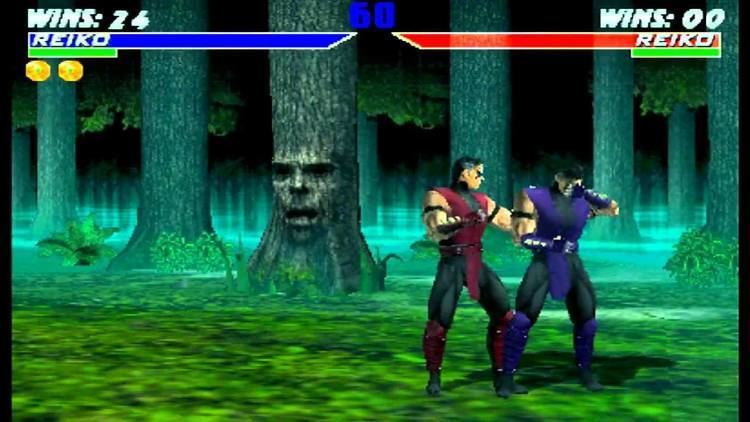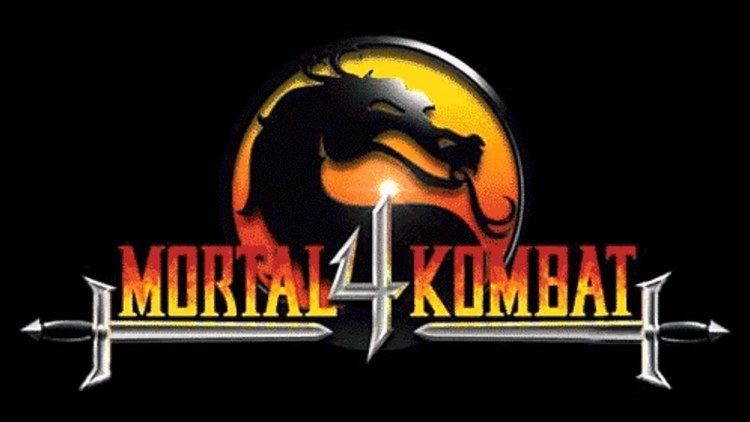8.6 /10 1 Votes
Initial release date 15 October 1997 | 4.3/5 Emuparadise Cabinet Standard | |||||||||||||||||||||||||||||||||
 | ||||||||||||||||||||||||||||||||||
Arcade system Midway Zeus hardwareMain CPU: TMS32031 (@ 50 MHz)Sound CPU: ADSP2104 (@ 16 MHz)Sound Chips: (2x) DMA-driven (@ 16 MHz) Similar Mortal Kombat games, Midway games, Fighting games | ||||||||||||||||||||||||||||||||||
Mortal kombat 4 arcade all fatalities
Mortal Kombat 4 (MK4) is the fourth main installment in the Mortal Kombat series of fighting games developed by Midway Games. Released to arcades in 1997, Mortal Kombat 4 is the first title from the series and one of the first made by Midway overall to use 3D computer graphics. It is also the last game of the series to have an arcade release. Eurocom later ported it to the PlayStation, Nintendo 64, PC, and Game Boy Color during 1998. An updated version titled Mortal Kombat Gold was released exclusively for the Dreamcast the following year.
Contents
- Mortal kombat 4 arcade all fatalities
- Mortal kombat 4 nintendo 64 sub zero gameplay
- Gameplay
- Plot
- Characters
- Development
- Release
- Home consoles
- Game Boy Color
- Reception
- Mortal Kombat Gold
- References

The gameplay system of Mortal Kombat 4 is similar to that of the previous games; one of the most notable additions is the use of weapons and objects during fights. The storyline chronicles the attack from the corrupted Elder God Shinnok against his former comrades who trapped him in the Netherealm many years prior to the beginning of the series. The other 17 playable characters take part in the battle between good and evil, with the forces of light trying to stop Shinnok and the forces of darkness from conquering all the realms.

While developing the game, the Midway staff had problems making the graphics as it was one of the first 3D fighting games they developed. Co-creator Ed Boon commented that the staff wanted to make Mortal Kombat 4 more violent than its predecessors, removing the comical finishing moves featured in them. Since its release, the game received generally positive response from critics, with the exception of the Game Boy Color port.

Mortal kombat 4 nintendo 64 sub zero gameplay
Gameplay

Mortal Kombat 4 is played in a similar way to the previous titles from the series with some changes. MK4 introduces a limited weapon system, allowing each character to take out a special weapon using a set button combination. Once equipped, the weapons are primarily used through the punch buttons. This includes swinging, clubbing or even tossing the weapons. The weapons can also be purposely dropped, in similar fashion to the arena objects such as severed heads and rocks; if an opponent's weapon is dropped, the other character is able to pick it up and use it. By sidestepping, the player is able to move in a 3D manner, shifting the camera angle, preventing both characters from holding up the weapons or objects they had on the ground.
MK4 added a "Maximum Damage" cap to the game's combo system, automatically breaking combos if they deal over a set amount of damage to a player and, thus, preventing infinite combos (although this cap can be removed with a code). Unlike Mortal Kombat Trilogy which contained multiple finishing moves of various kinds, Mortal Kombat 4 only has two Fatalities per character and two Stage Fatalities that can only be done in certain arenas and involve the character throwing the opponent to part of the arena where he or she dies. Unlike the first three games, this game does not include unplayable boss characters except Goro from the home versions.
Plot
Thousands of years before the setting of the first game, Shinnok, one of the Elder Gods who control the six realms in the Mortal Kombat universe, attempted to become the conqueror of them all. Thunder god Raiden fought and defeated Shinnok in a war that spanned hundreds of years, sending him to the Netherrealm, where he would be trapped forever. Now, Shinnok has managed to escape from the Netherealm with help from the sorcerer Quan Chi, and seeks vengeance against the Elder Gods who banished him. In his plan, he first conquers the realm of Edenia, with the aid of a traitor, Tanya, while he prepares to attack the Elder Gods. In order to stop Shinnok's menace, Raiden requests help from the Earthrealm warriors who saved the realms from Emperor Shao Kahn in previous titles.
Characters
The following is a list of the characters included in the Mortal Kombat 4 character selection roster.
MK4 introduces:
Returning characters include:
Development
Ed Boon, co-creator of the series, found it difficult to lead the development team for Mortal Kombat 4 due to how large the staff had become since the first Mortal Kombat title, with him as the only programmer. Therefore, Todd Allen and Mike Boon (Ed's younger brother) joined as programmers with Boon noting the staff was more than twice its original size. The Midway staff wanted to remove the comical elements from the previous Mortal Kombat titles, so they focused on the making of the Fatalities. On the other hand, the Animality finishing moves from Mortal Kombat 3 were removed since the transformation of a character into an animal was considered to be hard to make in 3D graphics. In order to make the Fatalities more entertaining, they decided to make some of the Fatalities replay from different camera angles. Since actors were no longer needed to make the characters' movements with the exception of adding some motion capture elements, the staff found it easier to make Fatalities as it was all done by computer animation.
The gameplay was planned to be similar to the predecessors although this would be the first game from the series to be made in 3D. The staff also wanted to avoid making all the mistakes they made in War Gods, Midway's first 3D title. To advertise the game, Midway organized a 35-stop road tour of the United States. The version of the game shown in the tour had nine characters, and within these nine was Noob Saibot, who would become a hidden character in the console ports only. As Ed Boon was skeptical about the quality of the result noting that the gameplay would be slower than previous titles, he decided to hand-animate frames with timings in a similar fashion to Street Fighter EX. Art director Tony Goskie created a 3D model for each character of the game, whom he called "Meat". It was later decided to make him a playable character as part of a hidden Easter egg. Players first learned of the character's given name after the text "Meat lives!" was placed on Ed Boon's website promoting Mortal Kombat 4's third arcade revision. Years after the game's release, Boon commented that he and the staff should not have made Shinnok the final boss from the game as previous titles used enormous characters as bosses.
Release
The arcade version of Mortal Kombat 4 was released on October 15, 1997 in North America and later that same year in Europe. The game was ported to the PlayStation, Nintendo 64 and Microsoft Windows. An upgraded version titled Mortal Kombat Gold was also released exclusively for the Dreamcast. A Game Boy Color game based on Mortal Kombat 4 was released as well.
Home consoles
Eurocom was in charge of making the console versions of the game and they worked for eight months to finish the Nintendo 64 port. One of their main objectives was to maintain 60 frames per second as they had never done that with a 3D fighting game. While all the traits from the arcade mode were added to the home version, Eurocom had to change the polygon count to "squeeze into the resources of the Nintendo 64". Eurocom was also assisted by Ed Boon and the lead artist on the arcade game, Dave Michicich. While the home versions were still in development, Ed Boon gave fans hints about things that would be in the ports of the game. These hints included Goro being a playable character and the extra costumes. Also added to the port is the Ice Pit, a snowy environment where players fight in an icy, carved-out pit. Another new feature added to these ports is a second set of alternate outfits for all characters. The arcade version provided only one set of alternate outfits which the player could unlock. The PC and PlayStation versions run FMV intro, bios and endings, due to the CD-ROM media. The Nintendo 64 version, being a cartridge game, uses the in-game character animations to run them just like its arcade counterpart.
Game Boy Color
The Game Boy Color version of MK4 was developed by Digital Eclipse and released by Midway. It is in 2D instead of the others' 3D. It features nine selectable characters: Raiden, Quan Chi, Fujin, Liu Kang, Sub-Zero, Reiko, Tanya, Scorpion, and the hidden character Reptile; Shinnok is still the final opponent. In addition, there are a few speech clips, and instead of using the in-game graphics for the Fatalities, the game uses short FMV clips. The Game Boy Color port's 2D engine reuses the game engine used in the Game Boy port of MK3, including the same character select screen, "Choose Your Destiny" screen, and how the characters move and interact. The background music was replaced with repetitive songs that bore instrumentation befitting a Game Boy release, and the port does not contain any blood outside of the Fatality videos. The combo system and weapons were also removed. However, the graphics for the port were above average for a Game Boy fighting title, and it contains many of the arcade's backgrounds in vivid clarity.
Reception
In October 1998, Midway announced the home venues' revenues thanks to the release of various titles including Mortal Kombat 4. Upon the start of the arcade's road tour, news programs commented on the violence from the game and expressed concern on how it would affect the players' personalities; Ed Boon replied that there were already games more violent than Mortal Kombat 4, which was only the most popular of the violent games and therefore the most prominent.
GameRankings had an average of 76.07% from 20 reviews for the Nintendo 64 version of the game. The PlayStation and PC ports received smaller averages with the PlayStation having 75.75% with 16 reviews, and the PC 72.14% with 14 reviews. Although various reviewers did not find it more entertaining than previous games, they still praised the gameplay. On the other hand, the gameplay was said to be very similar to the previous Mortal Kombat titles. The PlayStation and PC ports have been said to have improvements over the arcade game as having more responsive controls and the exclusive FMV scenes. However, IGN mentioned that playing the PC port would become "stale" unless the player "had an extra pad and a friend" and the Official UK PlayStation Magazine said that the game was "the same old stuff trotted out with a fresh coat of pixels. Tedious."
The Nintendo 64 port received positive response for being faithful to the arcade version, with GameSpot giving it a "Great" 8.9 and IGN a "Great" 8.8, though they noted that the graphics were not as good as those of the arcade. The game has received positive response due to the new 3D graphics, the improvement of combos, and how all the characters "are still as cheesy as ever" and because they still have their original movements with a few updates.
The Game Boy Color version received an average of only 46.00% with 3 reviews by GameRankings. It received poor reviews from publications such as GameSpot whose editor Jeff Gerstmann gave it a 3.5 out of 10 due to how different the game is from the other ports and how unresponsive the controls are. Similarly IGN's Peer Schneider criticized how limited the gameplay had become in this version and that defeating the opponent was relatively easier. He gave the game a "Poor" 4.0 out of 10.
In retrospective, GamesRadar criticized the endings for the Nintendo 64 version of the game using a compilation from them for an April Fool joke, labelling them as hilarious due to their poor quality. Mortal Kombat 4 was ranked as having third best Game Over screen of all time according to GamePro in 2009.
Mortal Kombat Gold
An expanded version titled Mortal Kombat Gold was developed by Eurocom and released in 1999 as a launch title for the Dreamcast in both regions, on September 9 on North America and on October 14 in Europe. The game contains several additional characters (Baraka, Cyrax, Kitana, Mileena, Kung Lao and Sektor) and stages, as well as a new weapon select mechanism.
